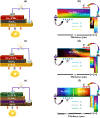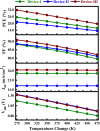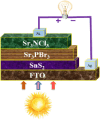Evaluation of design and device parameters for lead-free Sr3PBr3/Sr3NCl3 duel-layer perovskite photovoltaic device technology
- PMID: 39559582
- PMCID: PMC11570882
- DOI: 10.1039/d4ra07912d
Evaluation of design and device parameters for lead-free Sr3PBr3/Sr3NCl3 duel-layer perovskite photovoltaic device technology
Abstract
The study looks into how Sr3PBr3 and Sr3NCl3 double perovskite materials can be used as absorbers in perovskite solar cells (PSCs). Computational Sr3PBr3 and Sr3NCl3 simulations were employed to assess the performance of each absorber together with electron transport layers (ETL), with a particular emphasis on optimizing ETL thickness to improve charge transport and synchronize current outputs. The simulations yielded valuable insights into the electronic and optical characteristics of the individual absorbers. Subsequently, a tandem simulation was performed to adjust each layer's thickness, ensuring that both devices' current outputs were aligned for maximum system efficiency. The findings revealed that the tandem configuration of Sr3PBr3 and Sr3NCl3 surpassed the performance of the individual absorber setups, attributed to the optimized ETL thicknesses that enhanced charge transport and facilitated effective current matching. This study makes a significant contribution to the design and optimization of tandem PSCs utilizing Sr3PBr3 and Sr3NCl3 absorbers, paving the way for improved overall device efficiency. We investigated three device configurations to find the optimum structure. FTO/SnS2/Sr3PBr3/Ni, FTO/SnS2/Sr3NCl3/Ni, and FTO/SnS2/Sr3PBr3/Sr3NCl3/Ni are considered as Device-I, II, and III. In Device-I, the execution parameters are power conversion efficiency (PCE) of 24.26%, an open-circuit voltage (V OC) of 1.23 V, a short-circuit current density (J SC) of 24.65 mA cm-2, and a fill factor (FF) of 87.42%. For Device-II, PCE, FF, V OC, and J SC are correspondingly 20.35%, 87.91%, 1.28 V, and 18.07 mA cm-2. The further refined tandem configuration achieved a PCE of 30.32%, with a V OC of 1.27 V, an FF of 90.14%, and a J SC of 26.44 mA cm-2, demonstrating the potential of this methodology in enhancing PSC performance.
This journal is © The Royal Society of Chemistry.
Conflict of interest statement
The authors have no conflicts of interest.
Figures















References
-
- Jacobson M. Z. Delucchi M. A. Providing all global energy with wind, water, and solar power, Part I: Technologies, energy resources, quantities and areas of infrastructure, and materials. Energy Pol. 2011;39(3):1154–1169. doi: 10.1016/j.enpol.2010.11.040. - DOI
-
- GhaffarianHoseini A. Dahlan N. D. Berardi U. GhaffarianHoseini A. Makaremi N. GhaffarianHoseini M. Sustainable energy performances of green buildings: A review of current theories, implementations and challenges. Renew. Sustain. Energy Rev. 2013;25:1–17. doi: 10.1016/j.rser.2013.01.010. - DOI
-
- Ge T. S. Wang R. Z. Xu Z. Y. Pan Q. W. Du S. Chen X. M. et al., Solar heating and cooling: Present and future development. Renew. Energy. 2018;126:1126–1140. doi: 10.1016/j.renene.2017.06.081. - DOI
-
- DiCarlo A., Lamanna E. and Nia N. Y., Photovoltaics, EPJ Web Conf., 2020, vol. 246
-
- Takanabe K. Photocatalytic Water Splitting: Quantitative Approaches toward Photocatalyst by Design. ACS Catal. 2017;7(11):8006–8022. doi: 10.1021/acscatal.7b02662. - DOI
LinkOut - more resources
Full Text Sources
Research Materials
Miscellaneous

